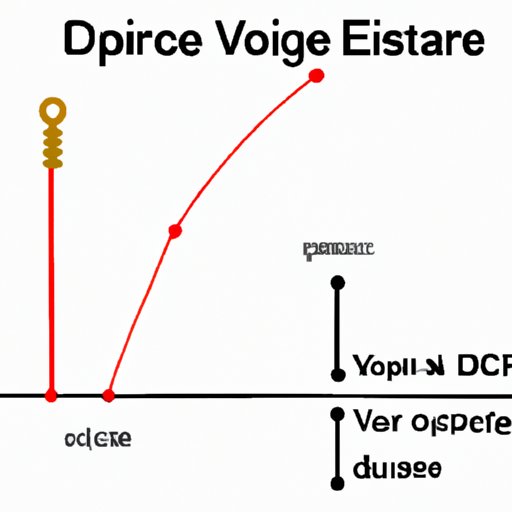
I. Introduction
Electrical circuits are an important part of our daily lives, from powering our homes to allowing us to charge our smartphones. Voltage drop is a common issue in electrical circuits, caused by the resistance of the wires that carry the current. This can lead to decreased performance and even damage to devices. Calculating voltage drop is vital for ensuring that circuits work efficiently and safely. In this article, we will explore the basics of voltage drop and provide tips and tricks for accurate calculations.
II. A Beginner’s Guide to Calculating Voltage Drop in Electrical Circuits
Voltage drop is the amount of voltage that is lost as electrical current passes through a wire with resistance. Ohm’s Law is the basic law of electricity that provides a formula for calculating voltage drop in a circuit. The formula is V = IR, where V is voltage, I is current, and R is resistance. To measure voltage drop in a circuit, you need a voltmeter. Simply connect the voltmeter to the circuit at the point where you want to measure the voltage drop.
Let’s take an example of a circuit that has a voltage of 12V and a resistor of 4Ω. The current passing through the circuit is 3A. To calculate the voltage drop across the resistor, we can use Ohm’s Law.
V = IR = 3A x 4Ω = 12V. Therefore, the voltage drop across the resistor is 12V.
III. Mastering Voltage Drop: Tips and Tricks for Accurate Calculations
There are several factors that can affect voltage drop, such as the length and cross-sectional area of the wire, the temperature of the wire, and the type of material used for the wire. Choosing the right wire gauge can also impact the voltage drop. Using a wire that is too small for the circuit can result in excessive resistance and higher voltage drop.
Fortunately, there are voltage drop calculator tools available that can help you determine the correct wire size and minimize voltage drop. These tools take into account the circuit voltage, length, current, and wire resistance, allowing you to choose the right wire gauge for your application. To ensure accurate calculations, it is essential to follow best practices, such as using the correct units and double-checking calculations.
IV. Understanding the Importance of Voltage Drop and How to Calculate it
Excessive voltage drop can lead to decreased circuit performance and even damage to equipment. For example, if the voltage drop in a circuit powering an LED light strip is too high, the light may appear dim or flicker. In extreme cases, the LED strip may not work at all.
The step-by-step calculation process for voltage drop includes calculating the resistance of the wire, finding the current flow in the circuit, and determining the voltage drop using Ohm’s Law. In practice, the calculation process can vary depending on the circuit type and the specific application.
Let’s take another example of a circuit that has a voltage of 24V and a length of 30 meters. The current passing through the circuit is 6A, and we are using a wire with a cross-sectional area of 0.5mm². The resistance of the wire can be calculated using the formula R = (ρ x L) / A, where ρ is the resistivity of the wire material, L is the length of the wire, and A is the cross-sectional area of the wire. Assuming the resistivity of the wire is 0.0172 Ω•mm²/m, we can calculate the resistance of the wire as follows:
R = (0.0172 Ω•mm²/m x 30m) / 0.5mm² = 1.032Ω
Next, we can use Ohm’s Law to calculate the voltage drop across the wire:
V = IR = 6A x 1.032Ω = 6.192V
Therefore, the voltage drop across the wire is 6.192V.
V. Solving the Mystery of Voltage Drop: Step-by-Step Calculation Guide
The calculation process for voltage drop depends on the type of circuit. For example, in a series circuit, the voltage drop is divided among the components, whereas in a parallel circuit, the voltage remains the same across each component.
To check and verify calculation results, you can measure the voltage drop using a voltmeter and compare it to the calculated value. If the measured value is significantly different from the calculated value, you may need to double-check your calculations and the assumptions made.
VI. Avoiding Problems in Electrical Circuits: Learn How to Calculate Voltage Drop
Excessive voltage drop can lead to a variety of issues, such as decreased performance, damage to equipment, and even electrical fires. By understanding the importance of voltage drop and how to calculate it, you can ensure that your electrical circuits work efficiently and safely. Troubleshooting tips, such as checking wire connections and using appropriate wire gauge, can also help identify and prevent voltage drop issues.
VII. Conclusion
In conclusion, calculating voltage drop is essential for ensuring that electrical circuits work efficiently and safely. By following the step-by-step calculation process, choosing the right wire gauge, and using voltage drop calculator tools, you can minimize voltage drop and prevent issues caused by excessive resistance. We encourage you to apply your knowledge of voltage drop in real-world situations and take steps to prevent voltage drop problems in your electrical circuits.




